Grand Cross of the Order of the Cross of Liberty
Vapaudenristin suurristi (VR SR)
Frihetskorsets storkors (FrK SK) |
| Without swords | With swords | Notes |


 | 

 | The Grand Cross of the Order of the Cross of Liberty is a large white-enamelled medal cross, measuring 53 mm in height and width. At its center is a white-enamelled, gold-edged heraldic rose on a black background, surrounded by a narrow golden ring. A golden swastika is embedded into the arms of the cross. When the decoration is awarded for wartime merits, it is attached to a 102 mm wide red ribbon, which has a 3 mm wide white stripe 2 mm from each edge. When awarded for peacetime merits, it is attached to a yellow ribbon, which has a 3 mm wide red stripe located 2 mm from each edge. The ribbon is worn from the right shoulder to the left hip. The breast star belonging to the Grand Cross is a silver, five-pointed star which is worn on the left side of the chest. The distance from the center to the tips of the radiating rays is 44 mm. At the center is a 33 mm diameter white-enamelled, gold-edged heraldic rose placed over a golden swastika on a black enamel background. This central design is surrounded by a circular golden frame with a red enamel background inscribed in gold letters with the words "ISÄNMAAN PUOLESTA" ("For the Fatherland"). The swords on the breast star are positioned so that their hilts rest on the two downward-facing rays of the star. The central motif covers part of the swords, with their tips re-emerging symmetrically on both sides of the upward-facing ray. The breast star belonging to the Grand Cross awarded without swords is identical to the version with swords, except that it does not include the swords. [2] |
Cross of Liberty, 1st Class with star
1. luokan Vapaudenristi rintatähtineen (VR 1 rtk.)
Frihetskorsets 1. klass med kraschan (FrK 1 mkr.) |
| Without swords | With swords | For gallantry | Notes |
 

 |  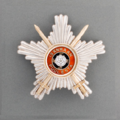

 | 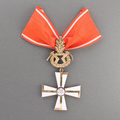 
 | The Cross of Liberty, 1st Class with star is similar in appearance to the Grand Cross but measures 49 mm in height and width. When awarded for wartime merits, it is worn around the neck on a 41 mm wide red ribbon, which has a 2 mm wide white stripe 1.5 mm from each edge. When awarded for peacetime merits, it is worn on a 41 mm wide yellow ribbon, which has a 2 mm wide red stripe 1.5 mm from each edge. The Cross of Liberty, 1st Class with star without swords is similar to the cross awarded with swords, but the wreath design matches that of the Grand Cross awarded without swords. The breast stars belonging to this decoration are identical in design to the breast stars of the Grand Cross, both with and without swords, but the distance from the center to the tips of the radiating rays is 41 mm, and the diameter of the central part is 29 mm. The breast stars are worn on the left side of the chest. [2] The award for gallantry with oak leaves can only be awarded together with the swords. |
Cross of Liberty, 1st Class
1. luokan Vapaudenristi )(VR 1)
Frihetskorsets 1. klass (FrK 1) |
| Without swords | With swords | For gallantry | Notes |


 | 

 | 
 | Cross of Liberty, 1st Class, both with and without swords, are identical to those described above but do not include the breast star. [2] |
Cross of Liberty, 2nd Class
2. luokan Vapaudenristi (VR 2)
Frihetskorsets 2. klass (FrK 2) |
|
| Without swords | With swords | For gallantry | Notes |


 | 

 | 
 | The Cross of Liberty, 2nd Class with swords is similar in appearance to the Grand Cross with swords but measures 40 mm in height and width. When awarded for wartime merits, it is worn on the chest on a 31 mm wide red ribbon with a rosette, featuring a 1.5 mm wide white stripe 1 mm from each edge. For peacetime merits, it is worn on a 31 mm wide yellow ribbon, which has a 1.5 mm wide red stripe 1 mm from each edge. The Cross of Liberty, 2nd Class without swords is identical to the version with swords but features a wreath design similar to that of the Grand Cross awarded without swords. [2] |
Cross of Liberty, 3rd Class
3. luokan Vapaudenristi (VR 3)
Frihetskorsets 3. klass (FrK 3) |
| With Red Cross | Without swords | With swords | For gallantry | Notes |


 | 

 | 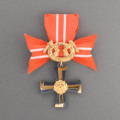

 | 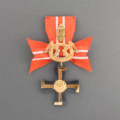
 | The Cross of Liberty, 3rd Class with swords is the same size as the Cross of Liberty, 2nd Class but is made of black oxidized iron. The heraldic rose in the center, the swastika on the arms of the cross, and the wreath design are gilded silver. For wartime merits, the decoration is worn on the chest with a 31 mm wide red ribbon with a rosette, featuring two 2 mm wide white stripes with a 4.5 mm wide red central stripe between them. For peacetime merits, it is worn on a 31 mm wide yellow ribbon with two 2 mm wide red stripes and a 4.5 mm wide yellow central stripe between them. The Cross of Liberty, 3rd Class without swords is the same size as the version with swords but is made of dark blue enamel and set in gilded silver. The heraldic rose in the center, the swastika on the arms of the cross, and the wreath design matching that of the Grand Cross without swords are gilded silver. [2] |
Cross of Liberty, 4th Class
4. luokan Vapaudenristi (VR 4 / VR 4 ra)
Frihetskorsets 4. klass (FrK 4 / FrK 4 fr) |
| With Red Cross | Without swords | With swords | For gallantry | Notes |
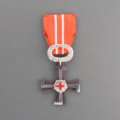

 | 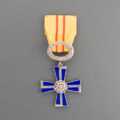

 | 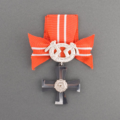

 | 
 | The Cross of Liberty, 4th Class with swords is identical in appearance and size to the Cross of Liberty, 3rd Class with swords . However, the heraldic rose in the center, the swastika on the arms of the cross, and the wreath design are made of silver. The decoration is worn on the chest with the same ribbon as the Cross of Liberty, 3rd Class with swords: a 31 mm wide red ribbon with a rosette, featuring two 2 mm wide white stripes with a 4.5 mm wide red central stripe between them. The Cross of Liberty, 4th Class without swords is identical in appearance to the Cross of Liberty, 3rd Class without swords but is set in silver. The heraldic rose in the center, the swastika on the arms of the cross, and the wreath design matching that of the Grand Cross without swords are made of silver. [2] |
Medal of Liberty, 1st Class
1. luokan Vapaudenmitali (VM 1)
Frihetsmedaljens 1. klass (FrM 1) |
Peacetime,
with Red Cross | Wartime,
with Red Cross | Peacetime | Wartime | Notes |

 | 
 | 
 | 
 | The Medal of Liberty, 1st Class is made of silver and has a diameter of 30 mm. On the obverse side, there is the crowned head of the lion from the Finnish coat of arms and an armored lion's arm wielding a sword, surrounded by the words "Urheudesta" – "För tapperhet" ("For Bravery"), separated by two heraldic roses. On the reverse side, within a laurel wreath, are the words "Suomen kansalta" ("From the People of Finland") and the year marking the start of the war during which the medal was awarded. When the medal is awarded for peacetime merits, it is otherwise identical to the wartime version, but on the obverse, the words "Urheudesta" – "För tapperhet" are replaced with "Isänmaan puolesta" – "För fosterlandet" ("For the Fatherland"). On the reverse side, within the laurel wreath, are the words "Suomen kansalta". The medal is worn on the chest, attached to a 31 mm wide blue ribbon with a 1.5 mm wide white stripe located 2.5 mm from each edge. [2] |
Medal of Merit, 1st Class
Vapaudenristin 1. luokan ansiomitali (VR Am 1)
Frihetskorsets förtjänstmedalj av 1. klass (FrK Fm 1) |
| Notes |

 | The Medal of Merit, 1st Class is identical to the 1st Class Medal of Liberty awarded for peacetime merits. It is worn on the chest, attached to a 31 mm wide green ribbon featuring a 7 mm wide black central stripe and a 3 mm wide red stripe located 2 mm from each edge. [2] |
Medal of Liberty, 2nd Class
2. luokan Vapaudenmitali (VM 2)
Frihetsmedaljens 2. klass (FrM 2) |
Peacetime,
with Red Cross | Wartime,
with Red Cross | Peacetime | Wartime | Notes |
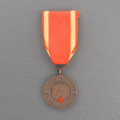
 | 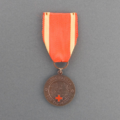
 | 
 | 
 | The Medal of Liberty, 2nd Class is identical in size and appearance to the Medal of Liberty, 1st Class, but it is made of bronze. The medal is worn on the chest, attached to a 31 mm wide red ribbon with a 4 mm wide yellow stripe located 1 mm from each edge. [2] |
Medal of Merit, 2nd Class
Vapaudenristin 2. luokan ansiomitali (VR Am 2)
Frihetskorsets förtjänstmedalj av 2. klass (FrK Fm 2) |
| Civil | Notes |

 | The Medal of Merit, 2nd Class is identical to the Medal of Liberty, 2nd Class awarded for peacetime merits but is worn on the same ribbon as the Medal of Merit, 1st Class. [2] |



































